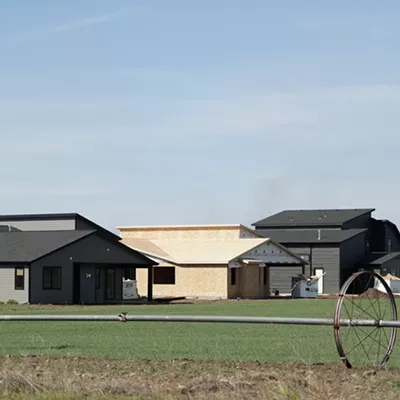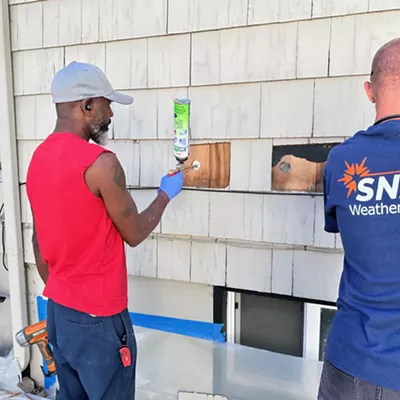Answer: Pulling itself up by its own bootstraps.
But that's not always as easy as it sounds, so for East Central Neighborhood's 11,900 residents, 1,400 businesses and those working in 90 social and human services organizations that serve the neighborhood, the formula is simple: building partnerships.
Service learning for both community college and university students has become one of the tools to building those partnerships.
"This neighborhood has assets," says Rhosetta Rhodes, Spokane Falls Community College's Service Learning coordinator and director of East Central Partnership Center. "We can't look at a neighborhood as being deficient and expect it to respond positively. There is a strong residential engagement here, and residents do come together effectively to be responsible for their neighborhood."
On paper and on the ground, East Central has some serious hurdles to overcome: a $28,580 median income, which is $5,000 per year lower than that of the rest of Spokane. Aging homes, 50 percent of which were built before 1939. On the education front, 13 percent in East Central had not attained a high school diploma compared to 8.6 percent of residents in the rest of Spokane.
Add to these stats the historical fact that construction of Interstate 90 decades ago abruptly cut the neighborhood in half and demolished hundreds of homes in its wake. Now I-90 expansion projects and the North Corridor Freeway will sever more of the neighborhood's connections and could demolish 80 businesses and more than 380 homes.
Daunting perceptions and realities can cripple a community's will, but East Central activists and these educational partnerships have instead energized the community to emphasize its assets and move toward revitalization.
As project director, Rhodes works with Community Service Learning classes across disciplines to help students gain in-the-community learning experiences while providing the East Central Neighborhood vital on-the-ground and technical assistance in drawing up a neighborhood plan.
"We wanted students to take something away from classes," says Vince Pascal, an Eastern Washington University marketing professor who has tailored classes around projects for the East Central Neighborhood plan. For him, learning takes place when students actually apply principles in real time and confront real-life problems and challenges.
"Students see the process all the way through," Pascal emphasizes. "In fact, the community gets to know us as academics, [and] students leave class as problem solvers."
Dick Winchell, who serves as the EWU project coordinator, has helped guide more than 20 classes in planning, business, social work and criminal justice to work with the East Central Partnership through a $400,000 Community Outreach Partnership Center (COPC) grant that HUD earmarked for East Central.
While the COPC grant stipulates that the neighborhood should first educate and train its workforce, then create jobs and, finally, work on neighborhood planning, Rhodes, Winchell and others involved in the East Central Neighborhood project realize a community doesn't always articulate clearly what it needs or wants. And that's where the social work, planning, business and history students come in.
"It's about creating long-term relationships," Winchell adds. "Students learn how to work in 'messy' organizations by building both knowledge and creating linkages."
For EWU students, this has included identifying stakeholders and working to engage those living in and involved with the neighborhood to commit to meetings and eventually to agree on action items. Students from both community college campuses and EWU are working on the community's needs, from projects like accessing all land use and future planning proposals tied to Growth Management Act tenets; park and business expansion; oral histories of the actual residents to get a sense of the neighborhood's collective narrative; and partnering up with the more than 40 faith-based human services programs.
"Any student from any department could be plugged into the neighborhood," says Jerry Numbers, chairman of the East Central Neighborhood Council.
& lt;span class= "dropcap " & A & lt;/span & s we sit in a meeting room at the East Central Community Center on South Stone Street, Numbers tells a group of EWU and SFCC administrators and teachers that the bricks and mortar came about more than three decades ago when the City of Spokane first applied for community development block grants through the U.S. Department of Housing and Urban Development. The East Central Neighborhood makes up a large geographic area: from Trent south to 14th Avenue, and from Havana all the way west to Division. It was one of three neighborhoods -- West Central and Northeast (Hillyard) being the others-- that were deemed in need of community centers.
Being a place with social needs has also translated into a reputation for being a tough neighborhood, too -- something Numbers says East Central is working to overcome. "East Central is a safe community," he says, "even though it has had a reputation over the years as being a tough area with high crime."
In 1979, the multi-purpose community center was opened in East Central, the only one of the three that is a department of the City. (The other two are non-profits and leased from the city.)
For Numbers and the people he works with, the ECCC is the heart and brain of the community. It houses a community computer center, vital for those writing resumes and applying for jobs. There is a Hispanic/Latino resource center, black parenting classes, a medical clinic, youth dance and recreation programs, Headstart, a senior center, a library and other programs for East Central residents to tap into.
However, with all those services provided by ECCC, and the fact that the neighborhood just received $2.5 million for an apartment-type living center to be built across from ECCC, Numbers and others still hearken back to the dynamic relationships the college and university students have created. It started in 2000 with a 10-year agreement between the East Central Neighborhood and the presidents of EWU and the Community Colleges of Spokane.
So far, more than 40 classes and more than 400 students have worked in East Central. More than 200,000 faculty, staff and student hours combined have been thrown into East Central projects, equating to more than $2 million of in-kind support.
"This partnership has just blossomed into so many projects EWU and CCS are coordinating here that we could have never imagined years ago," Numbers says. "We would not have gotten anywhere without the students."
















